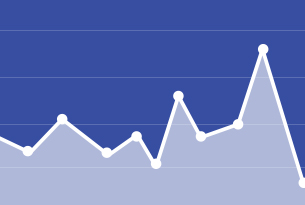Have you labored over your blog, Facebook, LinkedIn, or Twitter for years, only to suddenly find a huge drop in your traffic?
As managers begin to probe the Return on Social Media Investment, an unexpected reversal is frustrating – and can have direct impact on the organization’s brand… and those responsible for it.
Determining the reasons for an abrupt change requires some detective work. For a blog, here are just a few of the possible reasons for a drop:
- Another site that linked to yours no longer does.
- You may have been dropped from a blogroll.
- Because your content is duplicated on several pages throughout the internet, Google may be penalizing your search engine ranking.
- Google is now increasing the weighting for the searcher’s location – if your content is hosted “far away”, this may be hurting you for a segment of your audience.
- You’ve changed the domain of the blog, or you’ve changed the way the URL paths are coded.
- The writing style on your blog has changed, and your readers don’t like it.
- You’ve changed topics slightly, and your blog no longer appeals to certain readers… or to certain web sites: you may have lost both readers and links.
- The blog design has changed, and people don’t like it.
- You are now using too many (or too few) pictures.
- The physical server your blog is hosted on is overloaded, resulting in a too-slow page load.
- You’ve added more plug-ins, which have slowed your site even further.
- The growing segment of mobile users don’t like your mobile interface.
- A new smartphone or tablet was released, and your blog doesn’t take advantage of the platform.
- A new version of a browser has been released, and your blog looks terrible on it.
- The online advertising strategy (or spend) has changed, and fewer users are drawn to the blog.
- The blog’s URL is no longer featured in off-web advertising, collateral, or communications.
- A highly marketed competitive blog has started.
Key to determining the source of the change is a review of the analytics. For blogs, the key tool is Google Analytics; Facebook, YouTube, and other social platforms provide their own analytic tools as well. Some questions to ask: has the drop occurred because one particular source no longer providers users? Or one particular browser is no longer supported? (Or screen size?) Is there less click-through to secondary pages? And most importantly, did the drop happen all at once, or gradually over several months. Pinpointing the precise time that the change manifested itself – the inflection point – is key to diagnosing the source of the problem. And when the source is found, a prescriptive fix can be applied.
There are a number of situations when a drop in traffic may be expected. For example, if the Social Media strategy calls for a change in the blog’s focus, then it is perfectly natural – and even desirable – for non-target readers to quit.
This week’s action plan: If you are not reviewing your analytics on a regular basis, this is the week to start: 10 minutes is all it takes to quickly scan the numbers and charts. Not only does this provide an early warning of potential problems, but it also is the first step in measuring ROI.
This post has been written by 108’s Senior Advisor and former CEO Randall Craig.











